Finance Report: Business Calculations for Dominoz and Retail
VerifiedAdded on 2020/12/24
|15
|3619
|500
Report
AI Summary
This report presents a comprehensive financial analysis of Dominoz Pizza Enterprises Limited and Retail Food Group Limited, focusing on key business calculations and performance metrics. It begins by calculating holding period returns for both companies over a five-year period, followed by the determination of expected returns using probability distributions. The report then computes total returns to shareholders, considering both share price changes and dividends. A significant portion of the analysis is dedicated to examining the share price fluctuations and their impact on company performance, highlighting the contrasting trends between Dominoz, which shows positive growth, and Retail Food Group, which exhibits a decline. The analysis further delves into a detailed ratio analysis, including earnings per share, net profit margin, asset turnover, leverage, return on equity, quick ratio, and debt-to-equity ratio for both companies. A comparative and contrastive analysis of the performance of both companies, with a focus on growth in different financial ratios, is presented, highlighting the strengths and weaknesses of each company based on profitability, efficiency, and liquidity ratios. The report concludes with an evaluation of the factors influencing the financial performance of both companies and their implications for stakeholders.

Business Calculations
Paraphrase This Document
Need a fresh take? Get an instant paraphrase of this document with our AI Paraphraser
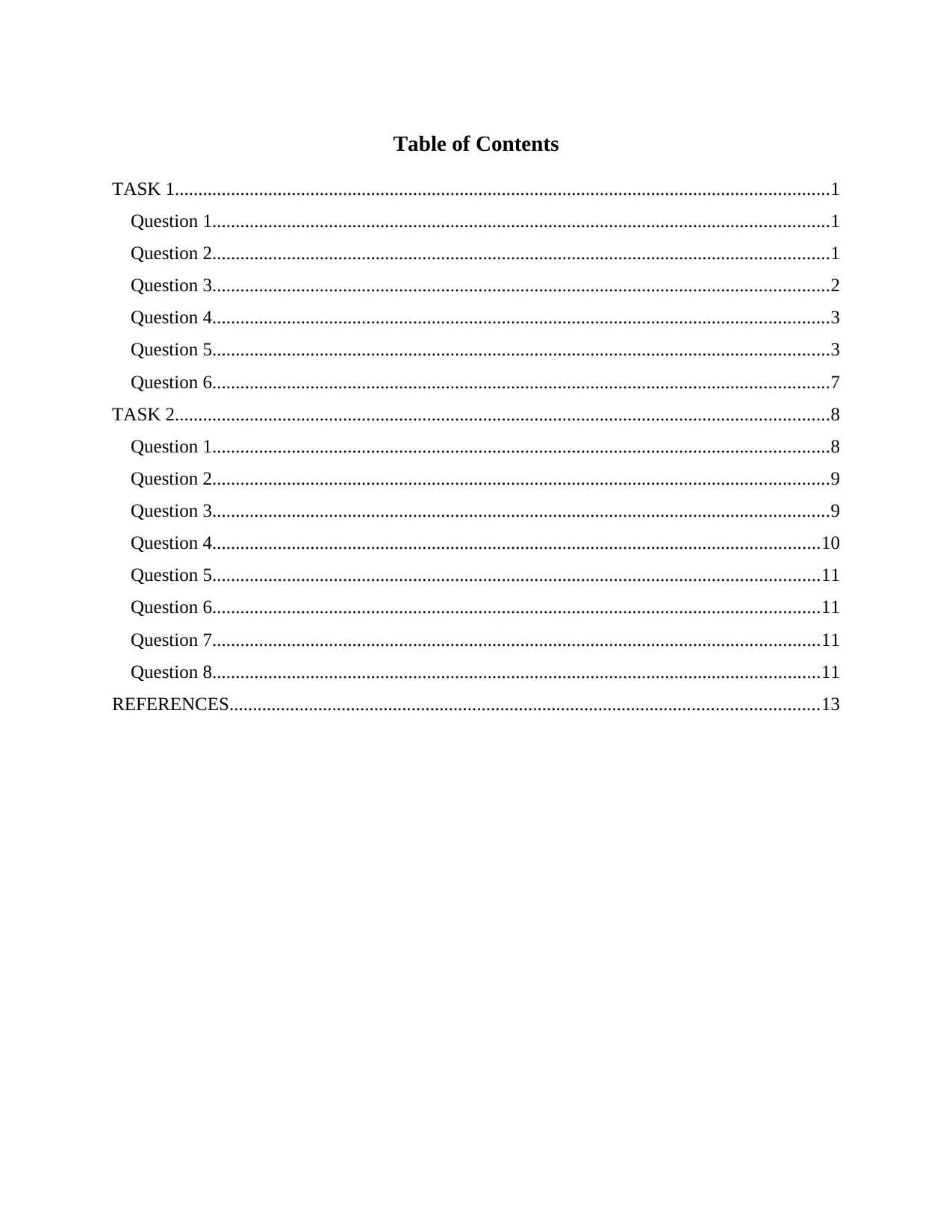
Table of Contents
TASK 1............................................................................................................................................1
Question 1....................................................................................................................................1
Question 2....................................................................................................................................1
Question 3....................................................................................................................................2
Question 4....................................................................................................................................3
Question 5....................................................................................................................................3
Question 6....................................................................................................................................7
TASK 2............................................................................................................................................8
Question 1....................................................................................................................................8
Question 2....................................................................................................................................9
Question 3....................................................................................................................................9
Question 4..................................................................................................................................10
Question 5..................................................................................................................................11
Question 6..................................................................................................................................11
Question 7..................................................................................................................................11
Question 8..................................................................................................................................11
REFERENCES..............................................................................................................................13
TASK 1............................................................................................................................................1
Question 1....................................................................................................................................1
Question 2....................................................................................................................................1
Question 3....................................................................................................................................2
Question 4....................................................................................................................................3
Question 5....................................................................................................................................3
Question 6....................................................................................................................................7
TASK 2............................................................................................................................................8
Question 1....................................................................................................................................8
Question 2....................................................................................................................................9
Question 3....................................................................................................................................9
Question 4..................................................................................................................................10
Question 5..................................................................................................................................11
Question 6..................................................................................................................................11
Question 7..................................................................................................................................11
Question 8..................................................................................................................................11
REFERENCES..............................................................................................................................13

TASK 1
Question 1
Holding period return: Income+ (End of period value- Initial value)/ Initial value
Dominoz Pizza Enterprises Limited
Year Income Initial
End of
year value
(Adjusted)
Holding
period
return
2013-14 0.331 10.84 19.66 1.145
2014-15 0.436 21.45 33.17 0.982
2015-16 0.619 34.43 64.1 1.481
2016-17 0.872 68.21 49.69 0.600
2017-18 1.03 51.77 51 1.015
Retail Food Group Limited:
Year Income Initial
End of
year value
(Adjusted)
Holding
period
return
2013-14 0.21 3.95 3.828 0.179
2014-15 0.228 4.53 4.76 0.279
2015-16 0.248 5.43 5.102 0.188
2016-17 0.293 5.56 4.549 0.111
2017-18 0.15 4.65 0.54 -0.734
Question 2
Expected return: R1 P1+ R2P2+....... RnPn
Note: In order to calculate expected return probability is distributed on the basis of
assumptions.
Dominoz Pizza Enterprises Limited
Holding Probability
1
Question 1
Holding period return: Income+ (End of period value- Initial value)/ Initial value
Dominoz Pizza Enterprises Limited
Year Income Initial
End of
year value
(Adjusted)
Holding
period
return
2013-14 0.331 10.84 19.66 1.145
2014-15 0.436 21.45 33.17 0.982
2015-16 0.619 34.43 64.1 1.481
2016-17 0.872 68.21 49.69 0.600
2017-18 1.03 51.77 51 1.015
Retail Food Group Limited:
Year Income Initial
End of
year value
(Adjusted)
Holding
period
return
2013-14 0.21 3.95 3.828 0.179
2014-15 0.228 4.53 4.76 0.279
2015-16 0.248 5.43 5.102 0.188
2016-17 0.293 5.56 4.549 0.111
2017-18 0.15 4.65 0.54 -0.734
Question 2
Expected return: R1 P1+ R2P2+....... RnPn
Note: In order to calculate expected return probability is distributed on the basis of
assumptions.
Dominoz Pizza Enterprises Limited
Holding Probability
1
You're viewing a preview
Unlock full access by subscribing today!
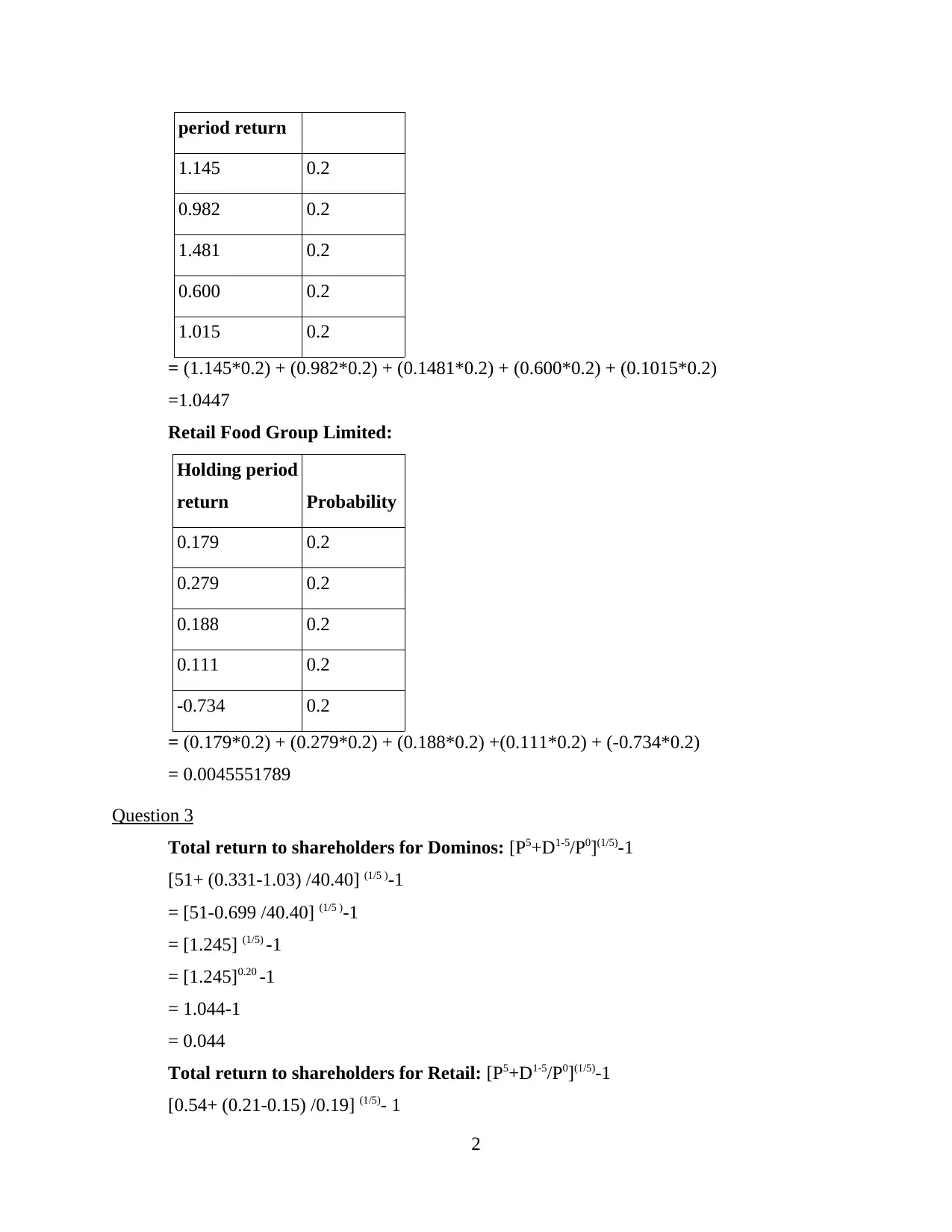
period return
1.145 0.2
0.982 0.2
1.481 0.2
0.600 0.2
1.015 0.2
= (1.145*0.2) + (0.982*0.2) + (0.1481*0.2) + (0.600*0.2) + (0.1015*0.2)
=1.0447
Retail Food Group Limited:
Holding period
return Probability
0.179 0.2
0.279 0.2
0.188 0.2
0.111 0.2
-0.734 0.2
= (0.179*0.2) + (0.279*0.2) + (0.188*0.2) +(0.111*0.2) + (-0.734*0.2)
= 0.0045551789
Question 3
Total return to shareholders for Dominos: [P5+D1-5/P0](1/5)-1
[51+ (0.331-1.03) /40.40] (1/5 )-1
= [51-0.699 /40.40] (1/5 )-1
= [1.245] (1/5) -1
= [1.245]0.20 -1
= 1.044-1
= 0.044
Total return to shareholders for Retail: [P5+D1-5/P0](1/5)-1
[0.54+ (0.21-0.15) /0.19] (1/5)- 1
2
1.145 0.2
0.982 0.2
1.481 0.2
0.600 0.2
1.015 0.2
= (1.145*0.2) + (0.982*0.2) + (0.1481*0.2) + (0.600*0.2) + (0.1015*0.2)
=1.0447
Retail Food Group Limited:
Holding period
return Probability
0.179 0.2
0.279 0.2
0.188 0.2
0.111 0.2
-0.734 0.2
= (0.179*0.2) + (0.279*0.2) + (0.188*0.2) +(0.111*0.2) + (-0.734*0.2)
= 0.0045551789
Question 3
Total return to shareholders for Dominos: [P5+D1-5/P0](1/5)-1
[51+ (0.331-1.03) /40.40] (1/5 )-1
= [51-0.699 /40.40] (1/5 )-1
= [1.245] (1/5) -1
= [1.245]0.20 -1
= 1.044-1
= 0.044
Total return to shareholders for Retail: [P5+D1-5/P0](1/5)-1
[0.54+ (0.21-0.15) /0.19] (1/5)- 1
2
Paraphrase This Document
Need a fresh take? Get an instant paraphrase of this document with our AI Paraphraser
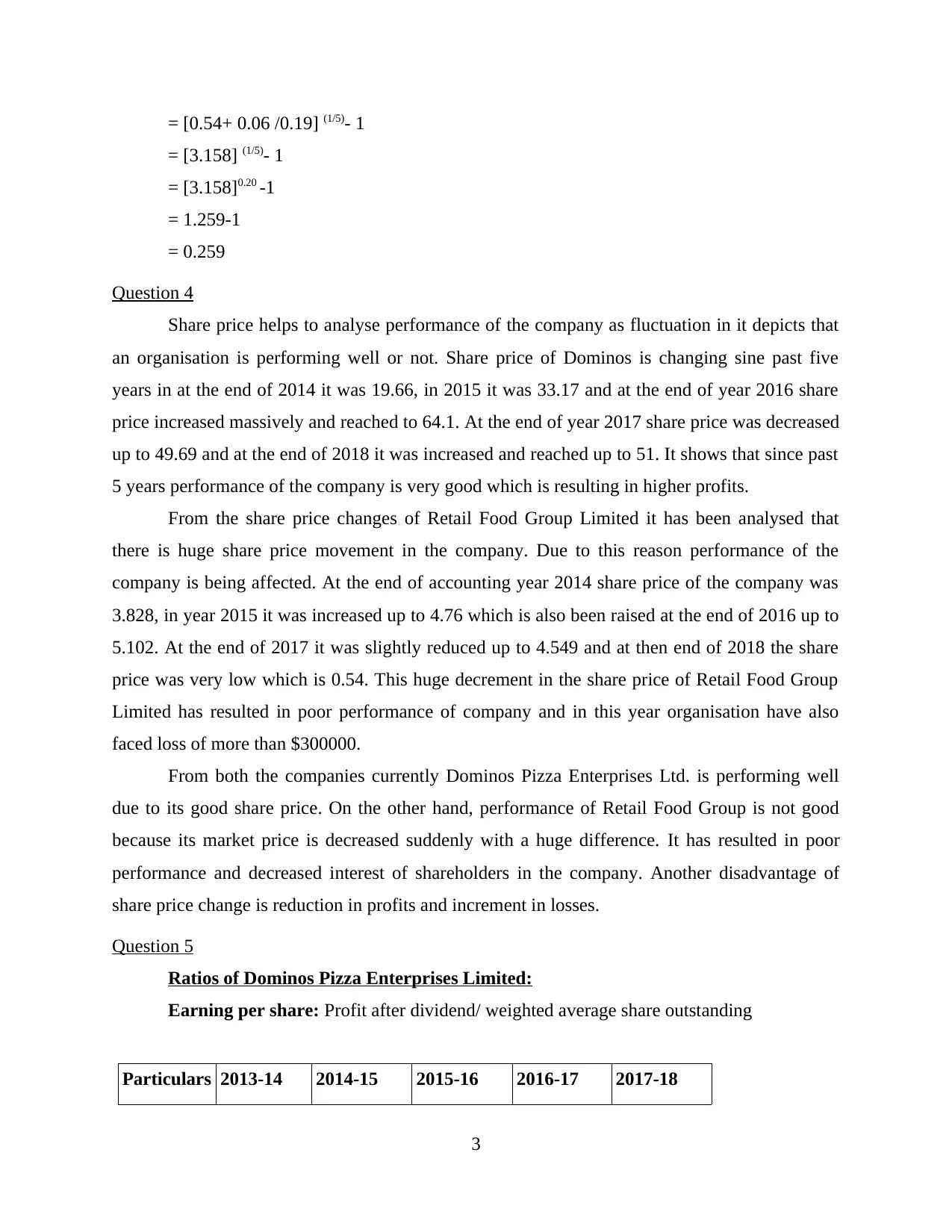
= [0.54+ 0.06 /0.19] (1/5)- 1
= [3.158] (1/5)- 1
= [3.158]0.20 -1
= 1.259-1
= 0.259
Question 4
Share price helps to analyse performance of the company as fluctuation in it depicts that
an organisation is performing well or not. Share price of Dominos is changing sine past five
years in at the end of 2014 it was 19.66, in 2015 it was 33.17 and at the end of year 2016 share
price increased massively and reached to 64.1. At the end of year 2017 share price was decreased
up to 49.69 and at the end of 2018 it was increased and reached up to 51. It shows that since past
5 years performance of the company is very good which is resulting in higher profits.
From the share price changes of Retail Food Group Limited it has been analysed that
there is huge share price movement in the company. Due to this reason performance of the
company is being affected. At the end of accounting year 2014 share price of the company was
3.828, in year 2015 it was increased up to 4.76 which is also been raised at the end of 2016 up to
5.102. At the end of 2017 it was slightly reduced up to 4.549 and at then end of 2018 the share
price was very low which is 0.54. This huge decrement in the share price of Retail Food Group
Limited has resulted in poor performance of company and in this year organisation have also
faced loss of more than $300000.
From both the companies currently Dominos Pizza Enterprises Ltd. is performing well
due to its good share price. On the other hand, performance of Retail Food Group is not good
because its market price is decreased suddenly with a huge difference. It has resulted in poor
performance and decreased interest of shareholders in the company. Another disadvantage of
share price change is reduction in profits and increment in losses.
Question 5
Ratios of Dominos Pizza Enterprises Limited:
Earning per share: Profit after dividend/ weighted average share outstanding
Particulars 2013-14 2014-15 2015-16 2016-17 2017-18
3
= [3.158] (1/5)- 1
= [3.158]0.20 -1
= 1.259-1
= 0.259
Question 4
Share price helps to analyse performance of the company as fluctuation in it depicts that
an organisation is performing well or not. Share price of Dominos is changing sine past five
years in at the end of 2014 it was 19.66, in 2015 it was 33.17 and at the end of year 2016 share
price increased massively and reached to 64.1. At the end of year 2017 share price was decreased
up to 49.69 and at the end of 2018 it was increased and reached up to 51. It shows that since past
5 years performance of the company is very good which is resulting in higher profits.
From the share price changes of Retail Food Group Limited it has been analysed that
there is huge share price movement in the company. Due to this reason performance of the
company is being affected. At the end of accounting year 2014 share price of the company was
3.828, in year 2015 it was increased up to 4.76 which is also been raised at the end of 2016 up to
5.102. At the end of 2017 it was slightly reduced up to 4.549 and at then end of 2018 the share
price was very low which is 0.54. This huge decrement in the share price of Retail Food Group
Limited has resulted in poor performance of company and in this year organisation have also
faced loss of more than $300000.
From both the companies currently Dominos Pizza Enterprises Ltd. is performing well
due to its good share price. On the other hand, performance of Retail Food Group is not good
because its market price is decreased suddenly with a huge difference. It has resulted in poor
performance and decreased interest of shareholders in the company. Another disadvantage of
share price change is reduction in profits and increment in losses.
Question 5
Ratios of Dominos Pizza Enterprises Limited:
Earning per share: Profit after dividend/ weighted average share outstanding
Particulars 2013-14 2014-15 2015-16 2016-17 2017-18
3
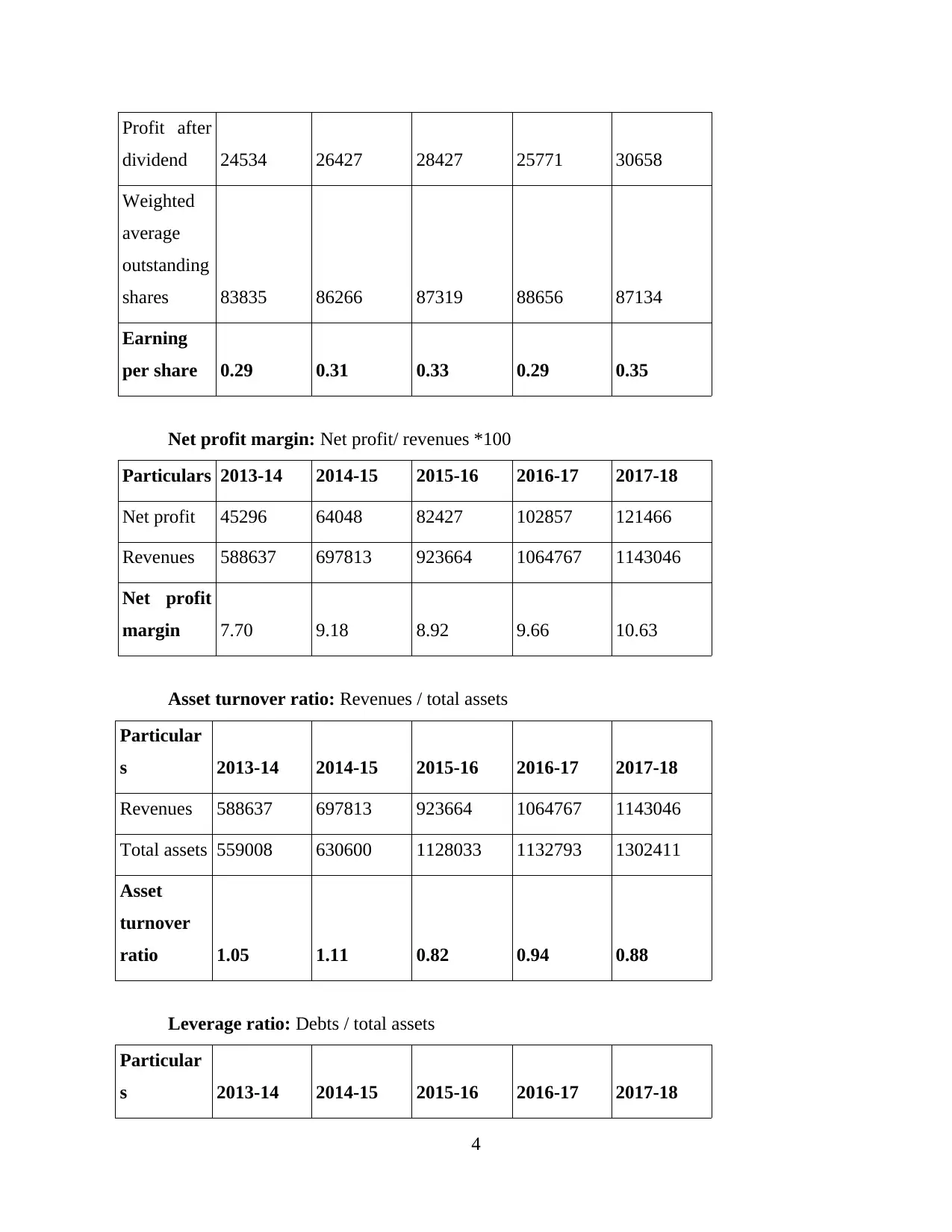
Profit after
dividend 24534 26427 28427 25771 30658
Weighted
average
outstanding
shares 83835 86266 87319 88656 87134
Earning
per share 0.29 0.31 0.33 0.29 0.35
Net profit margin: Net profit/ revenues *100
Particulars 2013-14 2014-15 2015-16 2016-17 2017-18
Net profit 45296 64048 82427 102857 121466
Revenues 588637 697813 923664 1064767 1143046
Net profit
margin 7.70 9.18 8.92 9.66 10.63
Asset turnover ratio: Revenues / total assets
Particular
s 2013-14 2014-15 2015-16 2016-17 2017-18
Revenues 588637 697813 923664 1064767 1143046
Total assets 559008 630600 1128033 1132793 1302411
Asset
turnover
ratio 1.05 1.11 0.82 0.94 0.88
Leverage ratio: Debts / total assets
Particular
s 2013-14 2014-15 2015-16 2016-17 2017-18
4
dividend 24534 26427 28427 25771 30658
Weighted
average
outstanding
shares 83835 86266 87319 88656 87134
Earning
per share 0.29 0.31 0.33 0.29 0.35
Net profit margin: Net profit/ revenues *100
Particulars 2013-14 2014-15 2015-16 2016-17 2017-18
Net profit 45296 64048 82427 102857 121466
Revenues 588637 697813 923664 1064767 1143046
Net profit
margin 7.70 9.18 8.92 9.66 10.63
Asset turnover ratio: Revenues / total assets
Particular
s 2013-14 2014-15 2015-16 2016-17 2017-18
Revenues 588637 697813 923664 1064767 1143046
Total assets 559008 630600 1128033 1132793 1302411
Asset
turnover
ratio 1.05 1.11 0.82 0.94 0.88
Leverage ratio: Debts / total assets
Particular
s 2013-14 2014-15 2015-16 2016-17 2017-18
4
You're viewing a preview
Unlock full access by subscribing today!
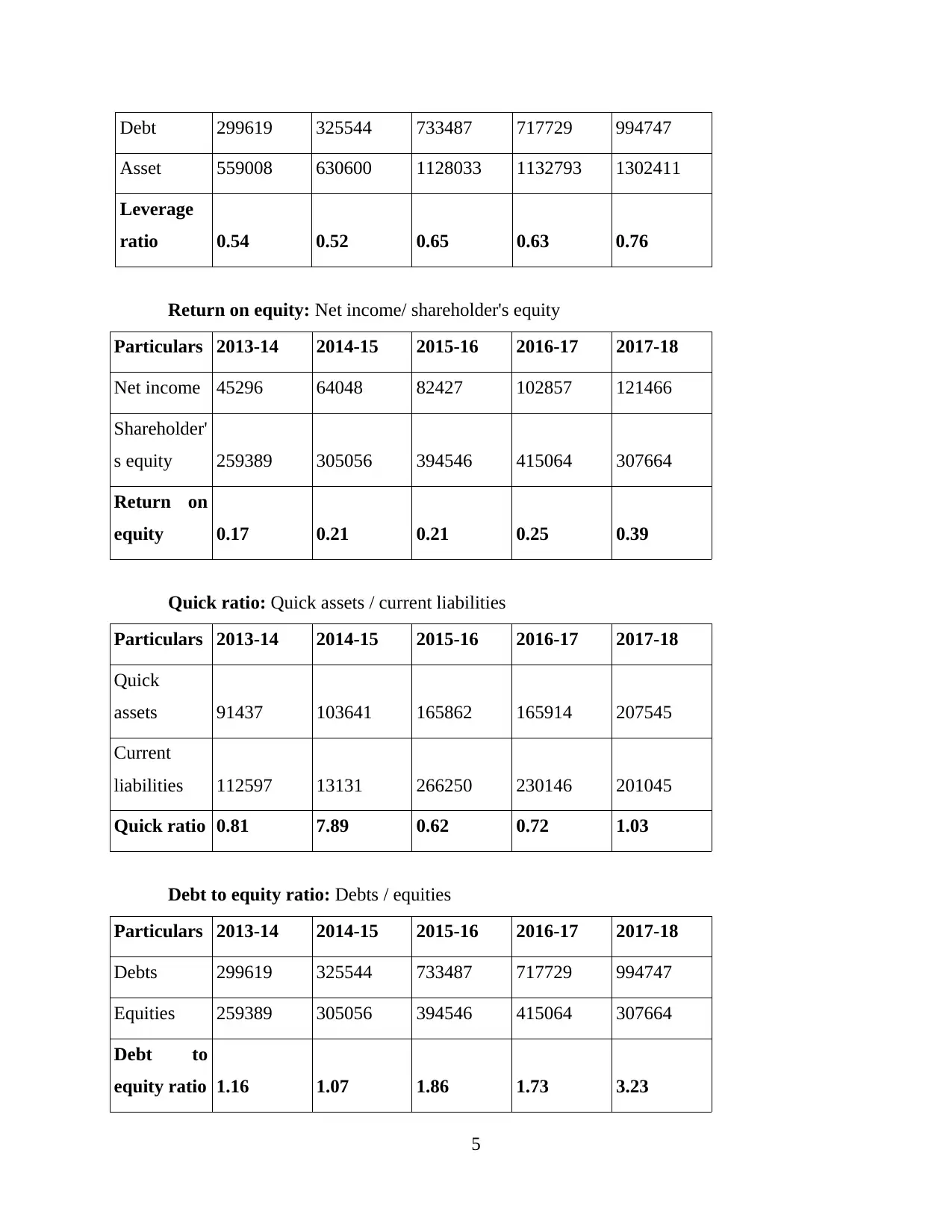
Debt 299619 325544 733487 717729 994747
Asset 559008 630600 1128033 1132793 1302411
Leverage
ratio 0.54 0.52 0.65 0.63 0.76
Return on equity: Net income/ shareholder's equity
Particulars 2013-14 2014-15 2015-16 2016-17 2017-18
Net income 45296 64048 82427 102857 121466
Shareholder'
s equity 259389 305056 394546 415064 307664
Return on
equity 0.17 0.21 0.21 0.25 0.39
Quick ratio: Quick assets / current liabilities
Particulars 2013-14 2014-15 2015-16 2016-17 2017-18
Quick
assets 91437 103641 165862 165914 207545
Current
liabilities 112597 13131 266250 230146 201045
Quick ratio 0.81 7.89 0.62 0.72 1.03
Debt to equity ratio: Debts / equities
Particulars 2013-14 2014-15 2015-16 2016-17 2017-18
Debts 299619 325544 733487 717729 994747
Equities 259389 305056 394546 415064 307664
Debt to
equity ratio 1.16 1.07 1.86 1.73 3.23
5
Asset 559008 630600 1128033 1132793 1302411
Leverage
ratio 0.54 0.52 0.65 0.63 0.76
Return on equity: Net income/ shareholder's equity
Particulars 2013-14 2014-15 2015-16 2016-17 2017-18
Net income 45296 64048 82427 102857 121466
Shareholder'
s equity 259389 305056 394546 415064 307664
Return on
equity 0.17 0.21 0.21 0.25 0.39
Quick ratio: Quick assets / current liabilities
Particulars 2013-14 2014-15 2015-16 2016-17 2017-18
Quick
assets 91437 103641 165862 165914 207545
Current
liabilities 112597 13131 266250 230146 201045
Quick ratio 0.81 7.89 0.62 0.72 1.03
Debt to equity ratio: Debts / equities
Particulars 2013-14 2014-15 2015-16 2016-17 2017-18
Debts 299619 325544 733487 717729 994747
Equities 259389 305056 394546 415064 307664
Debt to
equity ratio 1.16 1.07 1.86 1.73 3.23
5
Paraphrase This Document
Need a fresh take? Get an instant paraphrase of this document with our AI Paraphraser

Ratios of Retail Food Group Limited:
Earning per share: Profit after dividend/ weighted average share outstanding
Particulars 2013-14 2014-15 2015-16 2016-17 2017-18
Profit after
dividend 11517 10097 21507 19039 -328673
Weighted
average
outstanding
shares 139185 154876 164099 173441 180951
Earning
per share 0.08 0.07 0.13 0.11 -1.82
Net profit margin: Net profit/ revenues *100
Particulars 2013-14 2014-15 2015-16 2016-17 2017-18
Net profit 36861 34219 52963 61927 -306693
Revenues 56247 120768 164840 245873 297719
Net profit
margin
ratio 65.53 28.33 32.13 25.19 -103.01
Asset turnover ratio: Revenues / total assets
Particulars 2013-14 2014-15 2015-16 2016-17 2017-18
Revenues 56247 120768 164840 245873 297719
Total assets 398104 680048 753405 929628 600510
Asset
turnover
ratio 0.14 0.18 0.22 0.26 0.50
6
Earning per share: Profit after dividend/ weighted average share outstanding
Particulars 2013-14 2014-15 2015-16 2016-17 2017-18
Profit after
dividend 11517 10097 21507 19039 -328673
Weighted
average
outstanding
shares 139185 154876 164099 173441 180951
Earning
per share 0.08 0.07 0.13 0.11 -1.82
Net profit margin: Net profit/ revenues *100
Particulars 2013-14 2014-15 2015-16 2016-17 2017-18
Net profit 36861 34219 52963 61927 -306693
Revenues 56247 120768 164840 245873 297719
Net profit
margin
ratio 65.53 28.33 32.13 25.19 -103.01
Asset turnover ratio: Revenues / total assets
Particulars 2013-14 2014-15 2015-16 2016-17 2017-18
Revenues 56247 120768 164840 245873 297719
Total assets 398104 680048 753405 929628 600510
Asset
turnover
ratio 0.14 0.18 0.22 0.26 0.50
6
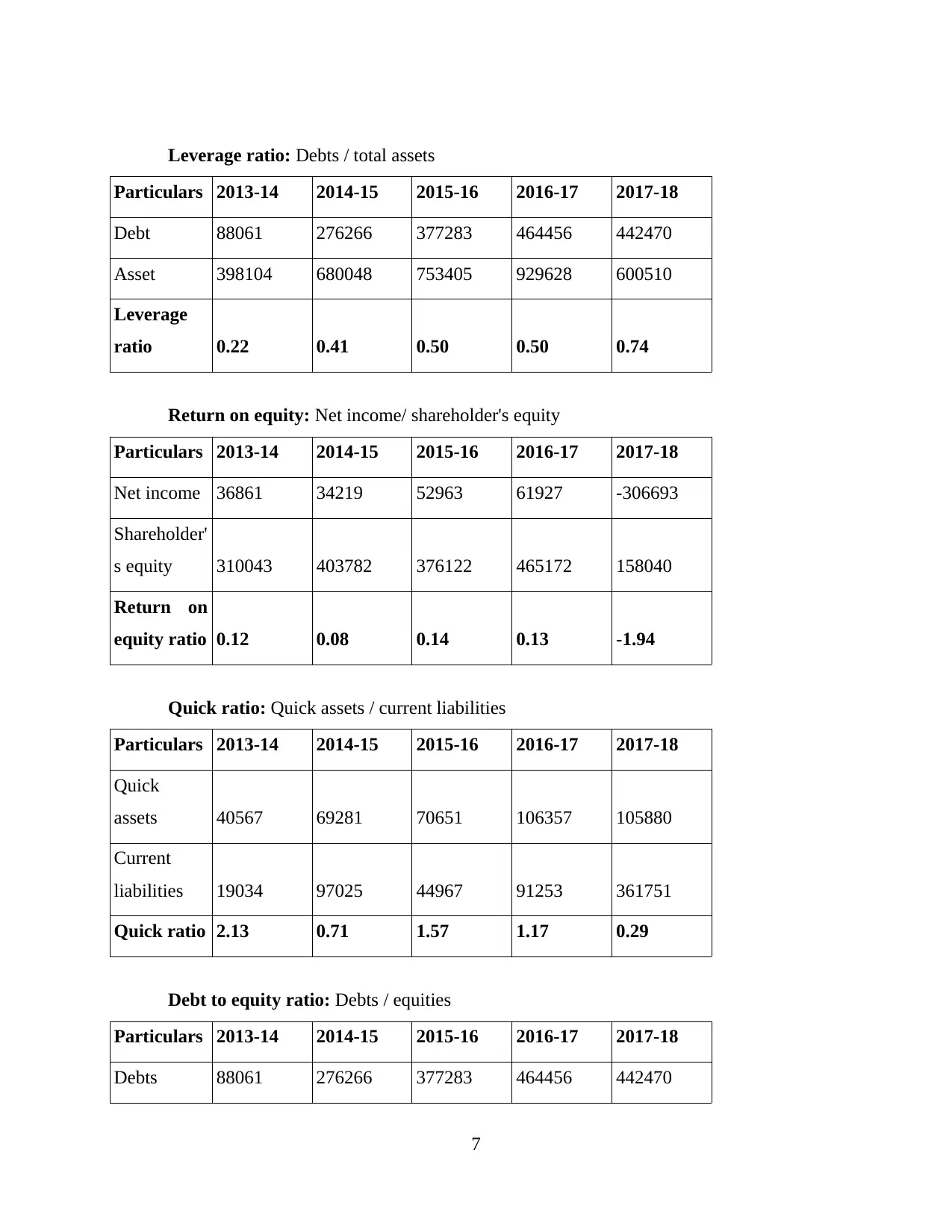
Leverage ratio: Debts / total assets
Particulars 2013-14 2014-15 2015-16 2016-17 2017-18
Debt 88061 276266 377283 464456 442470
Asset 398104 680048 753405 929628 600510
Leverage
ratio 0.22 0.41 0.50 0.50 0.74
Return on equity: Net income/ shareholder's equity
Particulars 2013-14 2014-15 2015-16 2016-17 2017-18
Net income 36861 34219 52963 61927 -306693
Shareholder'
s equity 310043 403782 376122 465172 158040
Return on
equity ratio 0.12 0.08 0.14 0.13 -1.94
Quick ratio: Quick assets / current liabilities
Particulars 2013-14 2014-15 2015-16 2016-17 2017-18
Quick
assets 40567 69281 70651 106357 105880
Current
liabilities 19034 97025 44967 91253 361751
Quick ratio 2.13 0.71 1.57 1.17 0.29
Debt to equity ratio: Debts / equities
Particulars 2013-14 2014-15 2015-16 2016-17 2017-18
Debts 88061 276266 377283 464456 442470
7
Particulars 2013-14 2014-15 2015-16 2016-17 2017-18
Debt 88061 276266 377283 464456 442470
Asset 398104 680048 753405 929628 600510
Leverage
ratio 0.22 0.41 0.50 0.50 0.74
Return on equity: Net income/ shareholder's equity
Particulars 2013-14 2014-15 2015-16 2016-17 2017-18
Net income 36861 34219 52963 61927 -306693
Shareholder'
s equity 310043 403782 376122 465172 158040
Return on
equity ratio 0.12 0.08 0.14 0.13 -1.94
Quick ratio: Quick assets / current liabilities
Particulars 2013-14 2014-15 2015-16 2016-17 2017-18
Quick
assets 40567 69281 70651 106357 105880
Current
liabilities 19034 97025 44967 91253 361751
Quick ratio 2.13 0.71 1.57 1.17 0.29
Debt to equity ratio: Debts / equities
Particulars 2013-14 2014-15 2015-16 2016-17 2017-18
Debts 88061 276266 377283 464456 442470
7
You're viewing a preview
Unlock full access by subscribing today!

Equities 310043 403782 376122 465172 158040
Debt to
equity ratio 0.28 0.68 1.00 1.00 2.80
Question 6
Comparison and contrasting of performance of Dominos and Retail according to growth
in different ratios:
Profitability ratios: From the growth in EPS and net profit margin of Dominos it has
been analysed that profitability of the company good and and its is stable. In year 2014 growth
was 29% and in year 2017 it has decreased up to 24%. Net profit margin of the company has
increased in year 2017 up to 13% as compare to 10% which is related to 2014. Profitability of
Retail Food Group Limited is not good according to its growth in EPS and net profit margin
(Share price and final accounts of Retail Food Group Ltd., 2019). In 2014 the growth in EPS
was 2% which was decreased in 2015 up to -17% which has affected organisation's profits. In
2016 massive growth in being recorded in this ratio and in 2017 the growth was decreased. There
is huge fluctuation in the profits of the company. Due to this reason its profitability is very low.
Growth in net profit margin is also not stable and fluctuations in this ratio has resulted in bad
performance of company (Ashalatha, Agarkhed and Patil, 2016).
Efficiency ratio: Growth in asset turnover ratio of Dominos is very high but it is
continuously decreasing. On the other hand, growth in efficiency ratio of Retail Food Group is
increasing continuously since 2014 to 2017. If growth are compared with each other then it
shows that Dominos is having huge growth as compare to Retail Food Group which has resulted
in good performance of Dominos (Share price and final accounts of Dominos Pizza Enterprises
Ltd., 2019).
Liquidity ratio: Growth in quick ratio shows that company is having higher liquidity or
not. With the help of it investors can make decision regarding making investment in the
company. Growth in quick ratio of Dominos Pizza Enterprises Limited is very low as compare to
Retail Food group Limited. Growth of Dominos is 81%, 80%, 63% and 72% for year 2014 to
2017 respectively. On the other hand, growth of Retail Food Group Ltd. In quick ratio is 213%,
75%, 157% and 117%. for the period of 2014 to 2017. It affects performance of company
8
Debt to
equity ratio 0.28 0.68 1.00 1.00 2.80
Question 6
Comparison and contrasting of performance of Dominos and Retail according to growth
in different ratios:
Profitability ratios: From the growth in EPS and net profit margin of Dominos it has
been analysed that profitability of the company good and and its is stable. In year 2014 growth
was 29% and in year 2017 it has decreased up to 24%. Net profit margin of the company has
increased in year 2017 up to 13% as compare to 10% which is related to 2014. Profitability of
Retail Food Group Limited is not good according to its growth in EPS and net profit margin
(Share price and final accounts of Retail Food Group Ltd., 2019). In 2014 the growth in EPS
was 2% which was decreased in 2015 up to -17% which has affected organisation's profits. In
2016 massive growth in being recorded in this ratio and in 2017 the growth was decreased. There
is huge fluctuation in the profits of the company. Due to this reason its profitability is very low.
Growth in net profit margin is also not stable and fluctuations in this ratio has resulted in bad
performance of company (Ashalatha, Agarkhed and Patil, 2016).
Efficiency ratio: Growth in asset turnover ratio of Dominos is very high but it is
continuously decreasing. On the other hand, growth in efficiency ratio of Retail Food Group is
increasing continuously since 2014 to 2017. If growth are compared with each other then it
shows that Dominos is having huge growth as compare to Retail Food Group which has resulted
in good performance of Dominos (Share price and final accounts of Dominos Pizza Enterprises
Ltd., 2019).
Liquidity ratio: Growth in quick ratio shows that company is having higher liquidity or
not. With the help of it investors can make decision regarding making investment in the
company. Growth in quick ratio of Dominos Pizza Enterprises Limited is very low as compare to
Retail Food group Limited. Growth of Dominos is 81%, 80%, 63% and 72% for year 2014 to
2017 respectively. On the other hand, growth of Retail Food Group Ltd. In quick ratio is 213%,
75%, 157% and 117%. for the period of 2014 to 2017. It affects performance of company
8
Paraphrase This Document
Need a fresh take? Get an instant paraphrase of this document with our AI Paraphraser
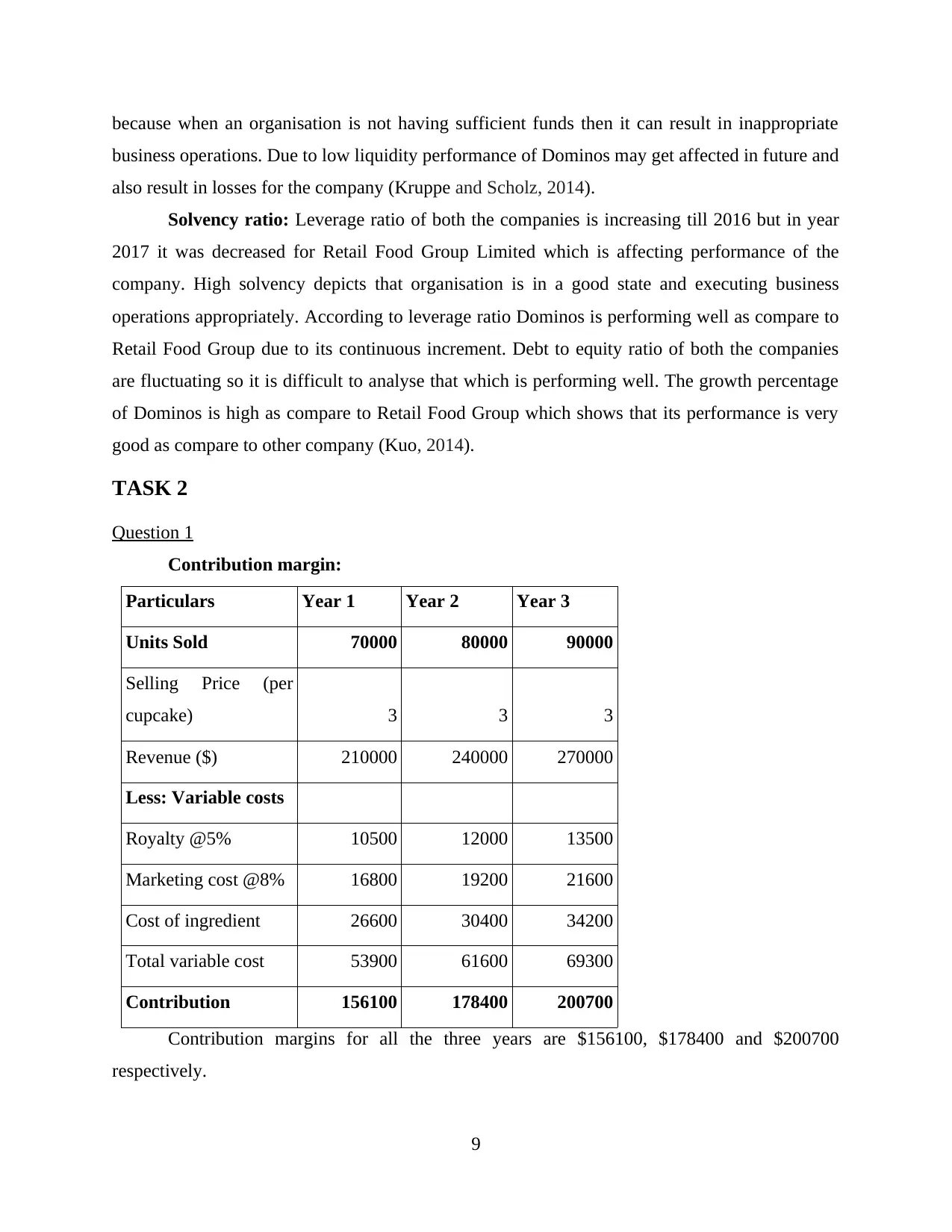
because when an organisation is not having sufficient funds then it can result in inappropriate
business operations. Due to low liquidity performance of Dominos may get affected in future and
also result in losses for the company (Kruppe and Scholz, 2014).
Solvency ratio: Leverage ratio of both the companies is increasing till 2016 but in year
2017 it was decreased for Retail Food Group Limited which is affecting performance of the
company. High solvency depicts that organisation is in a good state and executing business
operations appropriately. According to leverage ratio Dominos is performing well as compare to
Retail Food Group due to its continuous increment. Debt to equity ratio of both the companies
are fluctuating so it is difficult to analyse that which is performing well. The growth percentage
of Dominos is high as compare to Retail Food Group which shows that its performance is very
good as compare to other company (Kuo, 2014).
TASK 2
Question 1
Contribution margin:
Particulars Year 1 Year 2 Year 3
Units Sold 70000 80000 90000
Selling Price (per
cupcake) 3 3 3
Revenue ($) 210000 240000 270000
Less: Variable costs
Royalty @5% 10500 12000 13500
Marketing cost @8% 16800 19200 21600
Cost of ingredient 26600 30400 34200
Total variable cost 53900 61600 69300
Contribution 156100 178400 200700
Contribution margins for all the three years are $156100, $178400 and $200700
respectively.
9
business operations. Due to low liquidity performance of Dominos may get affected in future and
also result in losses for the company (Kruppe and Scholz, 2014).
Solvency ratio: Leverage ratio of both the companies is increasing till 2016 but in year
2017 it was decreased for Retail Food Group Limited which is affecting performance of the
company. High solvency depicts that organisation is in a good state and executing business
operations appropriately. According to leverage ratio Dominos is performing well as compare to
Retail Food Group due to its continuous increment. Debt to equity ratio of both the companies
are fluctuating so it is difficult to analyse that which is performing well. The growth percentage
of Dominos is high as compare to Retail Food Group which shows that its performance is very
good as compare to other company (Kuo, 2014).
TASK 2
Question 1
Contribution margin:
Particulars Year 1 Year 2 Year 3
Units Sold 70000 80000 90000
Selling Price (per
cupcake) 3 3 3
Revenue ($) 210000 240000 270000
Less: Variable costs
Royalty @5% 10500 12000 13500
Marketing cost @8% 16800 19200 21600
Cost of ingredient 26600 30400 34200
Total variable cost 53900 61600 69300
Contribution 156100 178400 200700
Contribution margins for all the three years are $156100, $178400 and $200700
respectively.
9
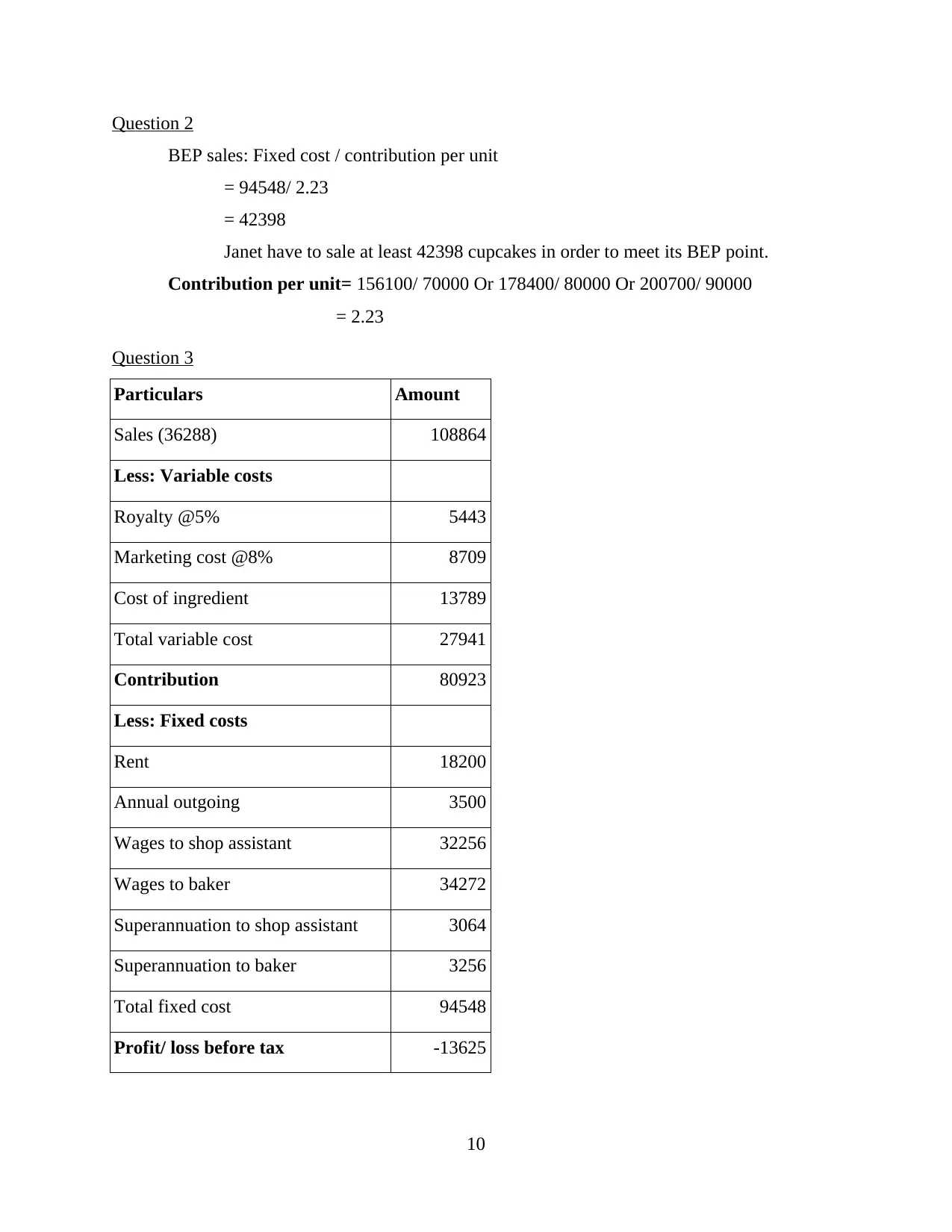
Question 2
BEP sales: Fixed cost / contribution per unit
= 94548/ 2.23
= 42398
Janet have to sale at least 42398 cupcakes in order to meet its BEP point.
Contribution per unit= 156100/ 70000 Or 178400/ 80000 Or 200700/ 90000
= 2.23
Question 3
Particulars Amount
Sales (36288) 108864
Less: Variable costs
Royalty @5% 5443
Marketing cost @8% 8709
Cost of ingredient 13789
Total variable cost 27941
Contribution 80923
Less: Fixed costs
Rent 18200
Annual outgoing 3500
Wages to shop assistant 32256
Wages to baker 34272
Superannuation to shop assistant 3064
Superannuation to baker 3256
Total fixed cost 94548
Profit/ loss before tax -13625
10
BEP sales: Fixed cost / contribution per unit
= 94548/ 2.23
= 42398
Janet have to sale at least 42398 cupcakes in order to meet its BEP point.
Contribution per unit= 156100/ 70000 Or 178400/ 80000 Or 200700/ 90000
= 2.23
Question 3
Particulars Amount
Sales (36288) 108864
Less: Variable costs
Royalty @5% 5443
Marketing cost @8% 8709
Cost of ingredient 13789
Total variable cost 27941
Contribution 80923
Less: Fixed costs
Rent 18200
Annual outgoing 3500
Wages to shop assistant 32256
Wages to baker 34272
Superannuation to shop assistant 3064
Superannuation to baker 3256
Total fixed cost 94548
Profit/ loss before tax -13625
10
You're viewing a preview
Unlock full access by subscribing today!
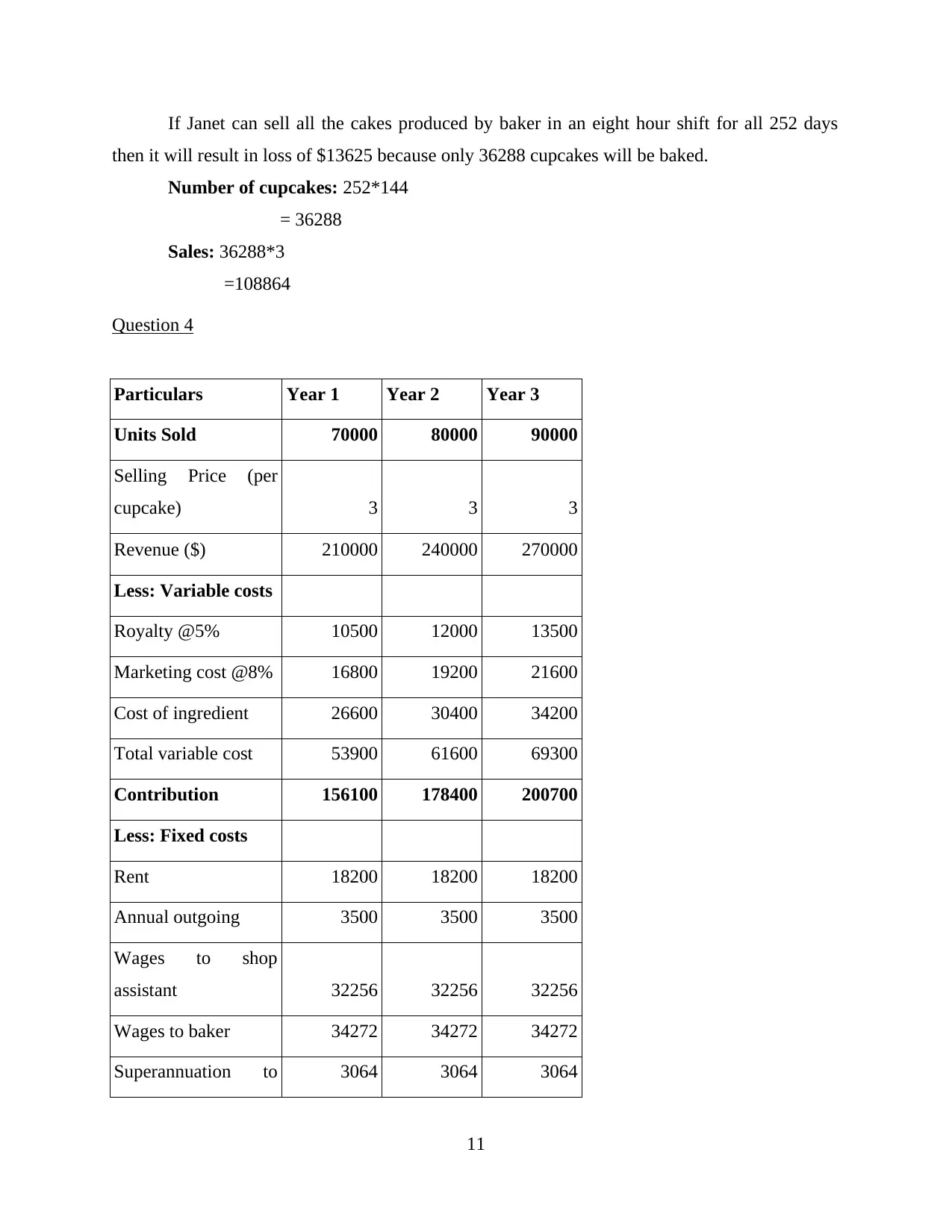
If Janet can sell all the cakes produced by baker in an eight hour shift for all 252 days
then it will result in loss of $13625 because only 36288 cupcakes will be baked.
Number of cupcakes: 252*144
= 36288
Sales: 36288*3
=108864
Question 4
Particulars Year 1 Year 2 Year 3
Units Sold 70000 80000 90000
Selling Price (per
cupcake) 3 3 3
Revenue ($) 210000 240000 270000
Less: Variable costs
Royalty @5% 10500 12000 13500
Marketing cost @8% 16800 19200 21600
Cost of ingredient 26600 30400 34200
Total variable cost 53900 61600 69300
Contribution 156100 178400 200700
Less: Fixed costs
Rent 18200 18200 18200
Annual outgoing 3500 3500 3500
Wages to shop
assistant 32256 32256 32256
Wages to baker 34272 34272 34272
Superannuation to 3064 3064 3064
11
then it will result in loss of $13625 because only 36288 cupcakes will be baked.
Number of cupcakes: 252*144
= 36288
Sales: 36288*3
=108864
Question 4
Particulars Year 1 Year 2 Year 3
Units Sold 70000 80000 90000
Selling Price (per
cupcake) 3 3 3
Revenue ($) 210000 240000 270000
Less: Variable costs
Royalty @5% 10500 12000 13500
Marketing cost @8% 16800 19200 21600
Cost of ingredient 26600 30400 34200
Total variable cost 53900 61600 69300
Contribution 156100 178400 200700
Less: Fixed costs
Rent 18200 18200 18200
Annual outgoing 3500 3500 3500
Wages to shop
assistant 32256 32256 32256
Wages to baker 34272 34272 34272
Superannuation to 3064 3064 3064
11
Paraphrase This Document
Need a fresh take? Get an instant paraphrase of this document with our AI Paraphraser
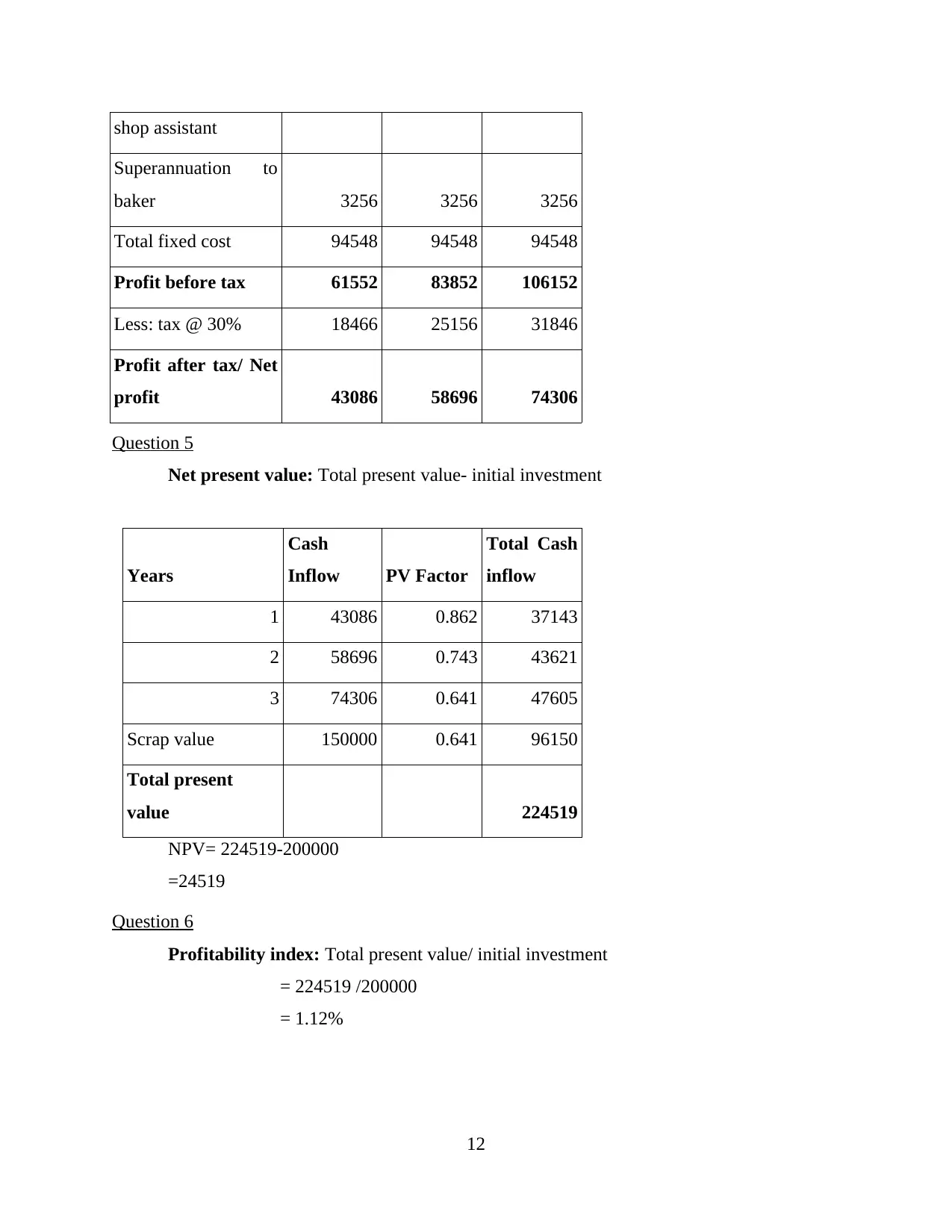
shop assistant
Superannuation to
baker 3256 3256 3256
Total fixed cost 94548 94548 94548
Profit before tax 61552 83852 106152
Less: tax @ 30% 18466 25156 31846
Profit after tax/ Net
profit 43086 58696 74306
Question 5
Net present value: Total present value- initial investment
Years
Cash
Inflow PV Factor
Total Cash
inflow
1 43086 0.862 37143
2 58696 0.743 43621
3 74306 0.641 47605
Scrap value 150000 0.641 96150
Total present
value 224519
NPV= 224519-200000
=24519
Question 6
Profitability index: Total present value/ initial investment
= 224519 /200000
= 1.12%
12
Superannuation to
baker 3256 3256 3256
Total fixed cost 94548 94548 94548
Profit before tax 61552 83852 106152
Less: tax @ 30% 18466 25156 31846
Profit after tax/ Net
profit 43086 58696 74306
Question 5
Net present value: Total present value- initial investment
Years
Cash
Inflow PV Factor
Total Cash
inflow
1 43086 0.862 37143
2 58696 0.743 43621
3 74306 0.641 47605
Scrap value 150000 0.641 96150
Total present
value 224519
NPV= 224519-200000
=24519
Question 6
Profitability index: Total present value/ initial investment
= 224519 /200000
= 1.12%
12

Question 7
From the net present value of the investment it has been analysed that the investment
which is being made by Janet is financially viable because when it will be sold by Janet then it
will result in profit of $24519. It has been recommended to Janet to make investment in this
project as it can help to attain profits in future (Schröder, Falk and Schmitt, 2015).
Question 8
There are various types of risks may take place while establishing a cup cake business.
All the risks which may affect business of Janet are as follows:
In cup cake business there is no exclusivity because it is not possible to patent a cup cake.
There are end number of competitors in this market because very low amount of
investment is required to enter (YU, YU and LAN, 2017).
Anyone can make cupcakes in order to attract customers creativity and innovation is
required.
Price of cup cakes is very high and it is not possible for all the customers to buy them.
Taste of customers changes with time which affects their buying behaviour against things
such as cup cakes.
In order to deal with all the above described challenges Janet can use following ways to
modify the business plan and reduce possibility of such types of risks:
Janet can use innovative techniques to bake cup cakes which can help to attract large
number of customers. For example, cup cakes which are carrying low calories could be
produced by Janet which will result in large number of clients because now a days people
are becoming health conscious.
As the market is saturated and pricing of the cupcakes is very high Janet can set prices to
the cup cakes according to market segment. Different types of cup cakes could be baked
for all type of customers whether they are from middle or upper class. It will help to
reach large number of clients and fulfil their needs (Sen and Sen, 2014).
Keeping detailed information regarding latest trends in baking could also help to deal
with above described risks because when cup cakes will be baked according to customer's
requirements then it can help to generate higher profits.
13
From the net present value of the investment it has been analysed that the investment
which is being made by Janet is financially viable because when it will be sold by Janet then it
will result in profit of $24519. It has been recommended to Janet to make investment in this
project as it can help to attain profits in future (Schröder, Falk and Schmitt, 2015).
Question 8
There are various types of risks may take place while establishing a cup cake business.
All the risks which may affect business of Janet are as follows:
In cup cake business there is no exclusivity because it is not possible to patent a cup cake.
There are end number of competitors in this market because very low amount of
investment is required to enter (YU, YU and LAN, 2017).
Anyone can make cupcakes in order to attract customers creativity and innovation is
required.
Price of cup cakes is very high and it is not possible for all the customers to buy them.
Taste of customers changes with time which affects their buying behaviour against things
such as cup cakes.
In order to deal with all the above described challenges Janet can use following ways to
modify the business plan and reduce possibility of such types of risks:
Janet can use innovative techniques to bake cup cakes which can help to attract large
number of customers. For example, cup cakes which are carrying low calories could be
produced by Janet which will result in large number of clients because now a days people
are becoming health conscious.
As the market is saturated and pricing of the cupcakes is very high Janet can set prices to
the cup cakes according to market segment. Different types of cup cakes could be baked
for all type of customers whether they are from middle or upper class. It will help to
reach large number of clients and fulfil their needs (Sen and Sen, 2014).
Keeping detailed information regarding latest trends in baking could also help to deal
with above described risks because when cup cakes will be baked according to customer's
requirements then it can help to generate higher profits.
13
You're viewing a preview
Unlock full access by subscribing today!
1 out of 15
Your All-in-One AI-Powered Toolkit for Academic Success.
+13062052269
info@desklib.com
Available 24*7 on WhatsApp / Email
![[object Object]](/_next/static/media/star-bottom.7253800d.svg)
Unlock your academic potential
© 2024 | Zucol Services PVT LTD | All rights reserved.